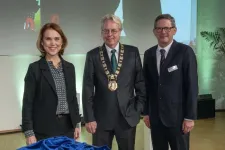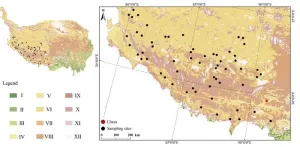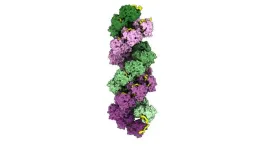(Press-News.org) Images
Michigan is a contender for a $50 million center aiming to build a quantum technology robust enough for the real world and demonstrate its utility. With a $1 million grant to explore options over the next year, the Michigan-led team is one of 11 funded in the first phase of the National Science Foundation's Quantum Science and Technology Demonstrations.
The team, whose project is called Quantum Photonic Integration and Deployment, or QuPID, aims to build the first chips that harness the incredible precision of light for real-world measurements in the field with quantum semiconductors. Working with leading industrial partners, the researchers will develop quantum systems that can perform the high-accuracy measurements.
"We're essentially trying to build quantum gadgets and demonstrate their performance so that people can integrate them into their own devices, whether that's AI, measuring the purity of a liquid, or predicting major storms months in advance," said Mackillo Kira, U-M professor of electrical and computer engineering and principal investigator of the project.
The team is targeting applications such as ultrasensitive environmental monitoring, GPS-free navigation, ultrasensitive semiconductor chip quality control and detailed geological mapping of underground structures from the air or satellites.
"Transforming the quantum advantage demonstrated in labs to serve wide applications in the real world comes down to simplifying and packaging the instrumentation needed to manipulate and measure light properties," said Parag Deotare, U-M associate professor of electrical and computer engineering and deputy director of the project.
"The center will explore creative approaches to achieve a robust quantum system that remains agnostic to the applications. In addition, we will create design kits that can be utilized globally by researchers and industries to adapt for specific applications."
In the first phase of this competitive program, the team will explore new applications and materials, building on previous successes. Their breakthroughs include detecting previously undetectable radio signals via quantum sensing, discovering new particle-like elements within quantum materials using quantum light, and switching quantum information at speeds millions of times faster than traditional computers. They have also introduced a groundbreaking material: ferroelectric nitrides that store electric fields much like fridge magnets retain magnetization.
"No other material shows such promise as an all-in-one quantum-integration solution," said Zetian Mi, U-M professor of electrical engineering and computer science and a co-principal investigator.
Ferroelectric nitrides could both produce and detect quantum entangled light, maintain internal quantum states, and convert light across a broad range of wavelengths without losses—all within a single chip. These versatile materials are also compatible with today's silicon-based microelectronics, paving the way for the planned laboratory-to-chip transition.
A key role of the potential quantum center is to recruit and educate future talent. In addition to collaborating with outreach facilities that are part of U-M, the team has commitments from the Ann Arbor Hands-On Museum and St. Clair County Community College.
The principal and co-principal investigators represent all three components of new technology development: theory, materials research and device integration. Kira's area is quantum theory, while Mi grows quantum materials atom by atom. Deotare and Jelena Vučković, professor of electrical engineering at Stanford, build quantum photonic devices, and Zheshen Zhang, associate professor of electrical and computer engineering at U-M, brings expertise in quantum sensing.
Beyond the team leads, QuPID includes researchers at Ohio State University, Harvard University, Michigan State University, the University of Arizona and the University of Southern California. Participating industry researchers hail from Honeywell, MONSTR Sense Technologies, TOPTICA Photonics, INTEL, KPIT, MITRE, Quantum Opus and Raytheon. The Air Force Research Laboratory and NASA Glenn Research Center are represented, as well as international collaborators from the University of Regensburg in Germany and Polytechnique Montréal in Canada.
By the end of the year, the team will submit a proposal laying out how they would pursue the most promising applications. If it succeeds, they will be awarded a further $4 million over two years to make progress toward demonstrating the technology in the lab—eight of the 10 initial teams are expected to be funded. After that, the NSF has budgeted for six teams to build their real-world-ready quantum devices, supported by up to $50 million over five years.
The Quantum Science and Technology Demonstrations are funded through the National Quantum Initiative Act.
The team will rely on the Lurie Nanofabrication Facility, the Michigan Center for Materials Characterization and individual faculty labs to produce and study quantum materials.
Kira and Deotare also have appointments in physics at U-M.
END
Toward quantum for the real world: Photonic team in running for center-level funding
A team led by the University of Michigan aims to bring the extraordinary accuracy of quantum laboratory measurements to real-world devices
2024-12-16
ELSE PRESS RELEASES FROM THIS DATE:
Inaugural ceremony for KIT’s new president, Jan S. Hesthaven
2024-12-16
View this album for photos of the event.
Hesthaven, a 58-year-old Dane, noted in his inaugural speech that KIT had a duty to be of service to society and that it faced major changes and challenges. “Increased internationalization will play a key role. We need to ensure that KIT attracts talent not only from Germany but also from around the world,” he said. The President named three challenges confronting society: new health technologies for an aging population, the spread of artificial ...
Plant DNA metabarcoding unlocks vegetation secrets of the Tibetan plateau
2024-12-16
A recent study led by Dr. Li from Zhejiang Normal University, in collaboration with international researchers, reveals the potential of plant DNA metabarcoding for monitoring plant compositions on the Tibetan Plateau (TP). The study, published in Science China Earth Sciences, highlights the advantages of sedimentary DNA (sedDNA) extracted from lake sediments over traditional pollen analysis, providing a more detailed and localized perspective on vegetation monitoring and reconstruction.
The study involved the surface sediments from 59 small lakes and ponds located in the southwestern Tibetan Plateau. Using plant DNA metabarcoding, ...
MSU study highlights negative impact of COVID-19 pandemic on special education students in Michigan
2024-12-16
MSU has a satellite uplink/LTN TV studio and Comrex line for radio interviews upon request.
EAST LANSING, Mich. – The COVID-19 pandemic adversely impacted K-12 education and its effects have been well documented. However, there has been less focus on how the pandemic affected the special education system and, specifically, that system here in Michigan.
To provide more insight and data, researchers at Michigan State University’s College of Education published a new study exploring learning gaps for students with disabilities and especially for those ...
VCU secures $9 million grant to establish Cancer Control Equity Research Center in Virginia
2024-12-16
Virginia Commonwealth University (VCU) has been awarded a five-year, $9 million grant from the National Cancer Institute to establish a pioneering Cancer Control Equity Research Center. This initiative aims to enhance the dissemination and implementation of health promotion and cancer prevention services for individuals and families residing in Virginia's Housing and Urban Development (HUD)-administered income-based housing communities in the Greater Richmond region and Hampton Roads.
Adults in under-resourced communities are placed at disproportionate risk for cancer, facing a higher incidence of the disease ...
AgriLife Research leads collaboration to address zebra chip disease
2024-12-16
Texas A&M AgriLife Research scientists are working on a new research project to fight plant diseases transmitted by psyllid insects — particularly the zebra chip disease, which has impacted potato production for decades.
Funded by a $682,500 grant from the U.S. Department of Agriculture National Institute of Food and Agriculture, this three-year project will investigate the mechanisms through which the bacterial pathogen Candidatus Liberibacter solanacearum affects plant and insect immune systems, leading to agricultural losses.
The findings by researchers in the Texas A&M College of Agriculture and Life Sciences could ...
New drug shows promise against Duchenne muscular dystrophy
2024-12-16
A novel drug holds promise for treating Duchenne muscular dystrophy (DMD), a rare genetic disorder that causes severe muscle degeneration.
McGill University researchers have discovered that an experimental compound called K884 can boost the natural repair abilities of muscle stem cells. Current treatments can slow muscle damage, but don’t address the root problem.
DMD affects about one in 5,000 boys worldwide, often leading to wheelchair dependence by the teenage years and life-threatening complications ...
Influenza virus genome: finally discovered in its coat
2024-12-16
To fight the virus that causes influenza, one of the avenues being explored by scientists is the development of drugs capable of destabilising its genome, made up of eight RNA1 molecules. But the challenge is daunting: each RNA molecule is tightly bound to an assembly of proteins which creates a double helix, forming a protective coat that is difficult to manipulate.
For the first time, however, the structure of this protective mantle and its interactions with the virus' RNA have been described on an atomic scale by scientists from the CNRS2 ...
AASM advocates for permanent sleep telehealth services to enhance patient care nationwide
2024-12-16
DARIEN, IL — The American Academy of Sleep Medicine has issued a new position statement advocating for permanent telehealth coverage, emphasizing its essential role in providing high-quality, patient-centered care for individuals with sleep disorders.
The position statement, published as an accepted paper in the Journal of Clinical Sleep Medicine, comes at a crucial turning point as current telehealth flexibilities implemented by the Centers for Medicare and Medicaid Services in response to the COVID-19 public health emergency are set to expire this month. The AASM emphasizes that permanent coverage with adequate reimbursement is vital for the ...
Staphylococcus aureus thwarts vaccines by turning on a protein that halts immune response
2024-12-16
Staphylococcus aureus (S. aureus) is a major cause of skin and soft tissue infections that can sometimes lead to sepsis and toxic shock syndrome. The microbe poses a significant threat to public health, made worse by the spread of methicillin-resistant Staphylococcus aureus bacteria (MRSA) in recent years. According to The Lancet, S. aureus was associated with more than one million deaths around the globe in 2019.
“It is a pathogen in dire need of control because it causes significant morbidity and mortality not just in the United States, but worldwide,” ...
Wedel studying how transnational networks shape non-Western offshore spaces
2024-12-16
Wedel Studying How Transnational Networks Shape Non-Western Offshore Spaces
Janine Wedel, Distinguished University Professor, Schar School of Policy and Government, received money for a project on the growing non-Western offshore system used by transnational networks emanating from autocratic regimes such as Russia to skirt international checks and balances. Wedel and her colleagues are investigating these informal networks and how they enable “weaponized corruption” — the use of corruption for geopolitical ends — and the evasion of Western sanctions. They are ...
LAST 30 PRESS RELEASES:
Young adults commonly mix cannabis with nicotine and tobacco
Comprehensive review illuminates tau protein's dual nature in brain health, disease, and emerging psychiatric connections
Book prepares K-12 leaders for the next public health crisis
Storms in the Southern Ocean mitigates global warming
Seals on the move: Research reveals key data for offshore development and international ecology
Sports injuries sustained during your period might be more severe
World's first successful 2 Tbit/s free-space optical communication using small optical terminals mountable on satellites and HAPS
Can intimate relationships affect your heart? New study says ‘yes’
Scalable and healable gradient textiles for multi‑scenario radiative cooling via bicomponent blow spinning
Research shows informed traders never let a good climate crisis go to waste
Intelligent XGBoost framework enhances asphalt pavement skid resistance assessment
Dual-function biomaterials for postoperative osteosarcoma: Tumor suppression and bone regeneration
New framework reveals where transport emissions concentrate in Singapore
NTP-enhanced lattice oxygen activation in Ce-Co catalysts for low-temperature soot combustion
Synergistic interface engineering in Cu-Zn-Ce catalysts for efficient CO2 hydrogenation to methanol
COVID-19 leaves a lasting mark on the human brain
Scientists use ultrasound to soften and treat cancer tumors without damaging healthy tissue
Community swimming program for Black youth boosts skills, sense of belonging, study finds
Specific depressive symptoms in midlife linked to increased dementia risk
An ‘illuminating’ design sheds light on cholesterol
Who is more likely to get long COVID?
Study showcases resilience and rapid growth of “living rocks”
Naval Research Lab diver earns Office of Naval Research 2025 Sailor of the Year
New Mayo-led study establishes practical definition for rapidly progressive dementia
Fossil fuel industry’s “climate false solutions” reinforce its power and aggravate environmental injustice
Researchers reveal bias in a widely used measure of algorithm performance
Alcohol causes cancer. A study from IOCB Prague confirms damage to DNA and shows how cells defend against it
Hidden viruses in wastewater treatment may shape public health risks, study finds
Unlock the power of nature: how biomass can transform climate mitigation
Biochar reshapes hidden soil microbes that capture carbon dioxide in farmland
[Press-News.org] Toward quantum for the real world: Photonic team in running for center-level fundingA team led by the University of Michigan aims to bring the extraordinary accuracy of quantum laboratory measurements to real-world devices



